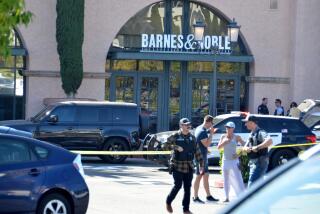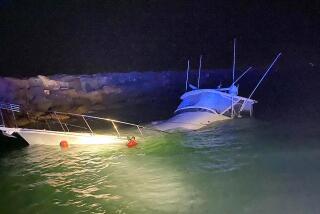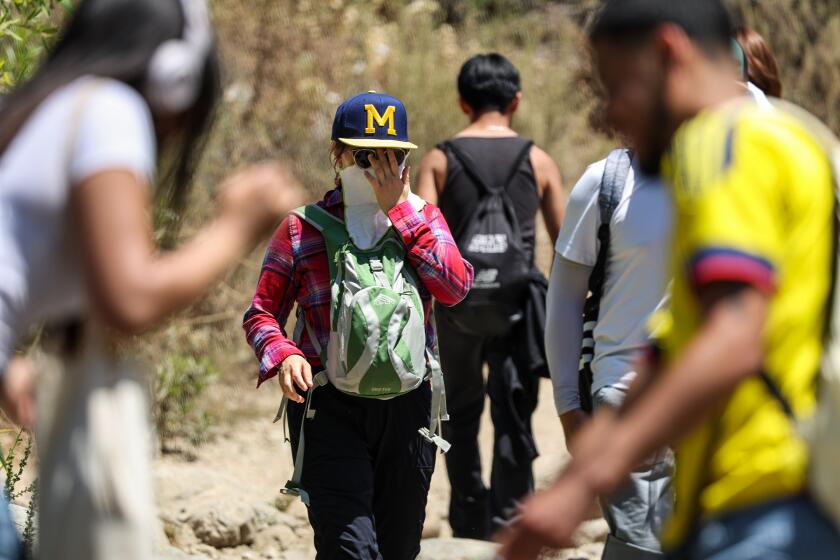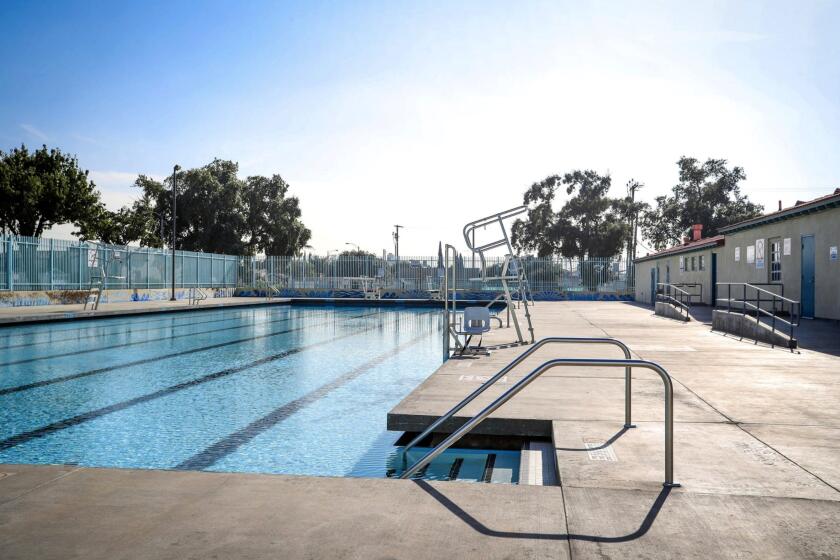Victim’s Resolve Brings Down a Star of Science
The girl set the showdown for the oak-shaded lawn in front of the South Pasadena public library, a lovely spot for an ugly encounter.
She was a high school student with a painful secret that surfaced on her wrists, scarred where she had cut herself.
He was William French Anderson, world-renowned scientist, the father of gene therapy and a martial arts expert with law enforcement connections from the FBI to the chief of his hometown police department in San Marino.
But he couldn’t handle the girl.
“God damn it, you’re like whining!” she barked.
He said he was sorry, again and again. “I will love you forever,” he told her. He was 67; she was 17.
“I just did it -- just something inside me was something just evil,” he said.
“Why did you molest me?” she demanded. He said he didn’t know.
The girl challenged him. “Are you guilty enough to turn yourself in, huh?”
No. That would damage, he said, “all the people who ironically look up to me as a model of the right way to live, people in Oklahoma [his native state].”
These words, captured by a police wire the girl wore during that 2004 encounter, were part of the evidence that helped convict Anderson on child molestation charges in July.
In her first media interview, the girl described how, after years of denial, she got herself to take on -- and eventually take down -- one of the biggest stars in medicine.
“I realized he could repeat what he did to me. He could do it to somebody else,” the girl, now a college student, told a reporter last week in the office of her lawyer, Mary Fulginiti. She spoke on condition of anonymity.
She said she told herself, “If you can’t find the strength to do it for yourself, then do it for someone else.”
Anderson is in custody and could not be interviewed for this story. His lawyer, Barry Tarlow, said he would comply with the judge’s order not to speak to the media about the case.
During his trial, Anderson testified that he might have emotionally abused the girl by pushing her too hard to do well in school and sports, but he said the sexual abuse claims were a vicious lie. He had cared deeply about her, he said. Defense lawyers argued that the girl’s mother, Anderson’s employee, wanted to usurp the scientist’s position as chief of a gene therapy lab at USC.
*
Anderson had a difficult childhood, which in some ways paralleled that of the girl.
Born in Tulsa, Okla., to an engineer father and journalist mother, Anderson was an unpopular stutterer a year younger and inches shorter than his classmates, according to a 2003 biography by Bob Burke and Barry Epperson titled “W. French Anderson: Father of Gene Therapy.”
As he recalled in the book, he obnoxiously pointed out his superior intelligence.
A few elders, including his grade school principal and the head of a summer boy’s camp, helped him improve his speech and social skills. By high school, he was a top middle-distance runner and a star in debate and drama as well as academics.
He was admitted to Harvard, where he flourished. Only a pulled hamstring kept him from the 1960 Olympic trials as a runner, his biography states. Academically, he did well enough to win a university scholarship for graduate study at Cambridge, where he met Kathryn Dorothy Duncan, a British undergraduate, in an anatomy class. They married on her graduation day and moved on to Harvard for medical school.
Photographs from the period show a strikingly attractive young couple. Kathy looked like Grace Kelly playing a doctor; her charm offset French’s lingering traces of awkwardness.
His wife called him “socially underdeveloped,” according to his biography. When they entertained at their home, “French played in the pool with the children while the adults chatted,” the book noted.
The Andersons told biographers they decided within a few years of their marriage to devote their lives to medicine instead of having children. Kathy became a pediatric surgeon, while Anderson, in 1965, joined the National Institutes of Health in Bethesda, Md.
Genetic engineering was in its infancy, and the thought of using it to cure human diseases was seen more as science fiction than as science by many.
Anderson nevertheless worked feverishly on first establishing its credibility, then making genetic therapy a reality. Each half day, he charted how he spent his time and gave himself a score: two points for research, one point for speeches and journal reading, zero points for administration or non-science.
In the late 1980s, Anderson and his collaborators performed an experimental implant of a harmless bacterial gene into a human. In their 1995 book “Altered Fates: Gene Therapy and the Retooling of Human Life,” journalists Jeff Lyon and Peter Gorner compared that scientific achievement with jet airplanes breaking the sound barrier.
In September 1990, Anderson and two colleagues implanted a healthy gene to correct 4-year-old Ashanti DeSilva’s defective immune system. Lyon and Gorner called the procedure “arguably the most audacious medical experiment in history, the first U.S. government-sponsored attempt to reprogram the genetic code of a living human being.”
Whether the operation or later medical treatment saved DeSilva’s life is now in dispute. The media then, however, hailed Anderson as the man who bested nature, the closest thing to playing God.
Critics, however, said he took too much credit for achievements in which other scientists shared.
In 1992, Anderson announced that he was leaving the NIH, his scientific home for 27 years. He was moving to Los Angeles, he said, for his wife.
Passed over for the chairmanship of the surgery department of the Children’s National Medical Center in Washington, D.C., she accepted the surgery chair at Childrens Hospital Los Angeles. She later settled a sex-discrimination lawsuit against her former employer.
Anderson founded the Gene Therapy Laboratories at USC. A year later, he hired a cardiologist from China who, according to Anderson’s biography, “was awed by French’s humility and his mission.” She was the girl’s mother.
“She told me he was a prominent person, a great person,” the girl recalled in the interview. “My mom told me to be really polite to him.”
But gene therapy failed to meet the heightened expectations that followed Anderson’s early success, and his lab at USC had lost most of its funding by 2003 and was set to close, even before he was accused of any crimes.
Since his early days at NIH, Anderson’s chief diversion from intense lab work was an equally intense interest in taekwondo and other martial arts. He became a black belt and served as the U.S. taekwondo team’s physician. News photographs showed him breaking boards with his fists. He later taught martial arts to children.
Without children of their own, the Andersons had long taken on what they called “surrogate children,” guiding nine through college and in some cases medical school.
In Los Angeles, the girl became Anderson’s next protege. Like him, she had early speech problems, talking only to her more outgoing twin sister in their own language.
The girl learned English in school but continued to let her twin speak for her. She had few friends and had been acting up at school.
Her mother believed that she would blossom under Anderson’s guidance, and he agreed.
He began teaching her karate when she was 9 and later drove her to soccer and softball practice. He also arranged speech therapy for her and told her mother he would prepare her to possibly attend Harvard.
By all outward appearances, the girl was thriving in elementary and middle school. Asked in one school assignment to name five things that made her special, she said, “I know French Anderson personally.”
Beneath the surface, however, Anderson was more of a buddy than mentor, the girl said during the interview. “He told me I could slack off in middle school because nobody would look at those grades [for college admission],” she said.
Anderson, who portrayed himself as never smoking or drinking, offered her alcohol and let her drive his car without a license, she testified during the molestation trial.
Anderson at trial said it never happened.
The girl was swinging playfully on a large hanging punching bag when he first touched her crotch, she testified.
Later, he would ask her to undress for “medical exams,” weighing her and touching her private parts, she said from the witness stand.
The worst abuse happened in the summers, when Anderson would disrobe, have her undress to her underwear and lie on a towel on the bed, she testified. She told jurors she would read Garfield comics while he thrust against her until he ejaculated.
The abuse stopped in ninth grade, after she began resisting more strongly, she testified. But their close relationship continued.
The girl lived with her family in a simple hillside house in South Pasadena, a short drive from Anderson’s much grander residence, a spacious Cape Cod on a row of mansions across from the Huntington library and gardens. The twins built a treehouse in Anderson’s backyard and had their friends over for get-togethers. Anderson bought the girl her prom dress.
During her sophomore year in high school, after the abuse had stopped, according to a police report, the girl took a friend to her basement and showed her a three-page letter describing the abuse. After the friend read it, the girl tore it up, the report said.
She swore the friend to secrecy and said she would “lie through her teeth” if police found out, the report added.
The girl later testified that she cared for Anderson and felt “he didn’t understand the extent that he had hurt me. And, I mean, he was this well-respected man that so many people look up to.”
Teammates and coaches, however, witnessed her angry outbreaks during practices. A teacher noticed her distress and sent the girl to the school counselor, according to court documents.
At first, she refused to detail her problem. Then she said a friend of hers had been molested. Finally, after several meetings, she told the counselor that she had been molested by her mother’s boss but didn’t want it reported, she testified.
The counselor, as required by state law, told police anyway.
When the mother arrived home to find her daughter speaking to police, she telephoned the family’s most-trusted advisor: French Anderson.
At first, the girl told officers there was no molestation. The counselor was wrong. Eventually, she confided the abuse.
By this time, the girl had cut off personal contact with Anderson. He sent her e-mails begging to see her. She didn’t have to talk to him or even acknowledge him, he wrote, he could just watch her at a soccer game.
“I would park in the back on Meridian, arrive just at the start, go up into the stands on the far right and sit by myself, never approach the field or make any contact, and leave right away at the end without talking to anybody,” he pleaded in e-mails presented during the trial.
She testified that she sent him e-mails asking him why he had abused her and insisting that he admit what he had done.
Anderson, also testifying in court, said his e-mail replies addressed emotional, not sexual, abuse. In one e-mail, he wrote he was considering suicide:
“If I saw you and your whole family destroyed, and my whole career down the tubes, and all the thousands of people abandoned who would have been helped by cures your mother and I are developing, then I can understand what would drive a person to suicide.... For me, a powerful 9-millimeter bullet through the side of the head would be the way to go.”
Directed by Los Angeles County sheriff’s deputies, who were given the case because of Anderson’s connections to the San Marino police force, the girl demanded the library meeting the Thursday before the Fourth of July weekend in 2004.
Anderson testified in his trial that his statements at the library were not sincere, that he was trying to tell the girl what she wanted to hear so he could get away. Afterward, French and Kathryn Anderson signed a joint letter to the San Marino department, whose chief had sent his two young children to the Anderson home for karate lessons.
The 3 1/2 -page, single-spaced letter speculated that the girl might be preparing to extort them: “If she has also descended into street drug use, then she may need money.... How do we protect ourselves from an extortion attempt? What should we do?”
Four weeks later, Anderson was arrested and released on bail, then arrested six months later, when a Maryland man claimed that Anderson had molested him 20 years earlier. Anderson was charged then with abusing the boy, but Maryland prosecutors eventually dropped the case.
A Los Angeles Superior Court jury on July 19 found Anderson guilty of four counts of continuous sex abuse and lewd acts toward a child under 14.
Anderson is undergoing psychological tests in prison in preparation for his Nov. 17 sentencing. Kathryn Anderson no longer lives in the house she had shared with her husband of 45 years. It was sold in May.
Anderson faces up to 22 years in prison, perhaps a life sentence for a man now 69 years old.
The girl says that her abuse could pain her forever. But the injury has also strengthened her sense of purpose. Powerfully built, she tells her story confidently. She is a soccer star at a prestigious college.
She says she wants to tell other victims to fight back, even against powerful people whom they may have cared for. “A lot of things were shattered,” she said in her interview. She had to accept that “a person I had trusted my whole life was not a good person.”
But she also found “so many people came to my side; they helped me realize the world’s a good place.”
Others should know, she says, “you do not have to be a victim forever.”
More to Read
Start your day right
Sign up for Essential California for news, features and recommendations from the L.A. Times and beyond in your inbox six days a week.
You may occasionally receive promotional content from the Los Angeles Times.






